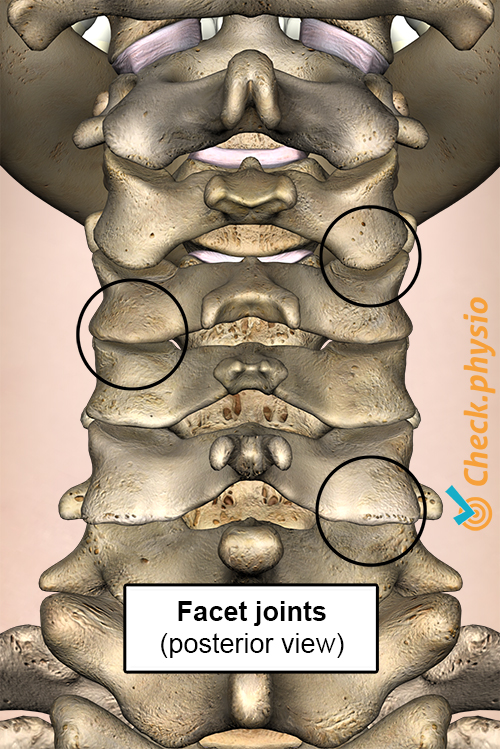Cervical facet syndrome
Pain of the facet joints in the neck
The facet joints are small joints in the spinal column. They connect the stacked vertebrae to each other and ensure that the neck can move. Pain in the facet joints is usually felt at the back of the neck - usually on one side - and may radiate into the shoulder.

Each vertebra in the spinal column has two facet joints which articulate with the ones from the vertebra above it. The joint surfaces, located both left and right of the vertebra, are covered with cartilage and surrounded by a joint capsule.
Description of condition
Cervical facet syndrome affects one or more facet joints. Various neck movements can compress the joint surfaces or stretch the capsules. Normally only one facet joint is affected, meaning that the pain is also felt only on one side of the back of the neck. The symptoms develop as a result of damage, inflammation or osteoarthritis (wear-and-tear) of the facet joints.
Cause and history
Signs & symptoms
- Pain in the back of the neck, usually to the left or right of the mid-line.
- The pain may radiate into the shoulder or the back of the head.
- Pain when bending the head back and/or maximal rotation of the neck.
- Mobility in these directions may be limited.
Normally, there are no neurological symptoms.
Diagnosis
The diagnosis is made based on the patient's story and the physical examination. If there is any uncertainty about the diagnosis, a facet joint block may be considered. X-rays usually do not provide much information and are only taken to look for other possible sources of pain.
A facet joint block involves injecting a local anesthetic and a steroid (anti-inflammatory) in the facet joint. The aim is to reduce the pain and simultaneously examine whether the injected facet joint is the source of the pain. If the pain goes away, there is reasonable certainty that the facet joint was the cause of the problems.
Treatment
The physiotherapy treatment is generally aimed at increasing the mobility of the facet joints and reducing pain. This is achieved using passive mobilizations and (active) exercise therapy.
Exercises
The exercises should be built up gradually. View the exercise program with exercises for the cervical facet syndrome here .
You can check your symptoms using the online physiotherapy check or make an appointment with a physiotherapy practice in your locality.


References
CBO (2012). Aspecifieke klachten arm, nek en/of schouders (KANS). Concept richtlijn.
Cleland, J.A. & Koppenhaver, S. (2011). Netter's orthopaedic clinical examination: an evidence-based approach. 2nd ed. Philadelphia: Saunders Elsevier.




